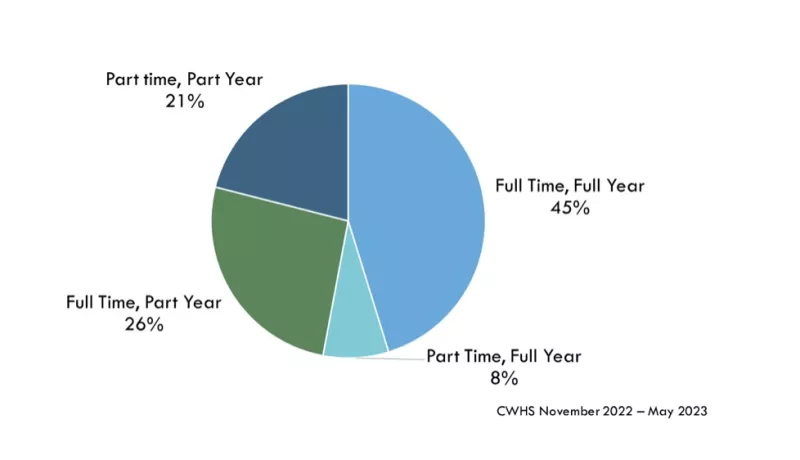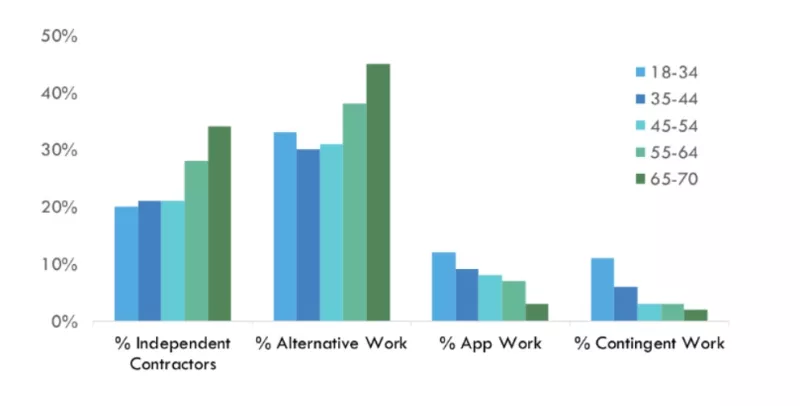Introduction to the CWHS
Between September 2022 and May 2023, the California Work and Health Survey (CWHS) interviewed 4,014 Californians between the ages of 18-70 about their employment status, working conditions within their jobs, physical & mental health, demographics, and financial well-being. The employment battery included questions about second jobs and jobs worked in the past thirty days, in order to more comprehensively capture the total number of jobs as well as the extent of non-standard work. We define non-standard work as including a wide variety of work arrangements, including independent contracting, on-call employment, working through a temporary agency, having work subcontracted to a firm, app-based work, and contingent employment.
Additionally, the CWHS will provide longitudinal data by recontacting 25% of the original respondents about two years after the initial interview. The resulting dataset will provide a time series of working conditions, financial status, and health variables that researchers can use to establish the relationship between non-standard employment at one time and changes in health status later.
The CWHS is the California Labor Laboratory’s attempt to collect data about a unique era in labor history. As many scholars have discussed, work has changed dramatically since the turn of the 21st century. If the paradigm of work has shifted, the paradigm under which occupational health surveys collect data must shift as well. The CWHS brings together both health and occupation indicators, allowing for meaningful side-by-side comparison often lacking in other surveys which address health or occupation alone. The ultimate goal of producing this dataset is to provide researchers beyond the Labor Lab the opportunity to work with data that probes modern workers’ lives in creative and elucidating ways.
CWHS Insights into Non-Standard Work
The responses to the CWHS capture key insights into the prevalence of non-standard work in the current labor market. As illustrated in the chart below, our findings show that among people employed within the past month, only 45% work full-time for the entire year. More than half of California workers are not working a standard “9 to 5” job, instead choosing to participate in non-standard work of some form.
Many of these non-standard California workers are partaking in a form of “alternative employment.” Alternative employment is a category of non-standard work defined by the Bureau of Labor Statistics (BLS) as independent contracting, on-call work, employment through a temporary agency, or subcontracted employment.
When asked about any primary job respondents held in the past month, 34% reported being employed in an alternative work arrangement. In fact, findings from the CWHS show that all forms of non-standard work are predominantly done as main jobs. It is revelatory that non-standard working conditions of all kinds are not relegated to “side hustles” or second jobs. More often than not, contingent or independent contractor work makes up the majority of the hours an individual spends working, if they do contingent or independent contractor work. The CWHS estimates that there are more than 6 million Californians doing non-standard work as their main job – that's one out of three working Californians! Therefore, it is important that we understand the impacts of non-standard work on the health and wellbeing of workers.
In particular, companies that rely heavily on app-based workers at the point of service, such as Uber or Lyft, often assert or imply in advertisements and internal messaging that it’s mostly work done on the side. It is possible that when Uber, Lyft, and other “gig-based” companies first entered the mainstream, their assertions were accurate: their workers saw it as a way to earn extra money on the side without sacrificing flexibility or control over their personal time. However, our survey responses demonstrate that the majority of app-based workers today do app-based work as their main form of employment.
CWHS Insights into Affected Workers
The CWHS reveals that specific subpopulations are more likely to be engaged in non-standard employment arrangements. People with disabilities and workers age 65+ are each 1.3x more likely to be in a nonstandard arrangement; the age distribution of forms of nonstandard work can be seen in the graph below. People with a high school education or less are 1.5x more likely to be in a nonstandard arrangement than people with any amount of college education. However, women and men participate in nonstandard arrangements at roughly the same rate.
On top of the poor economic outcomes associated with these forms of work, individuals involved in non-standard work are often not covered by U.S labor laws and are not guaranteed access to benefits. Workers employed in forms of non-standard employment such as app-based work or independent contracting are more likely to experience wage theft, and to be in poverty. The CWHS will help elucidate the exact role which non-standard work plays in cycles of poverty and social exclusion.
Read More:
- Goals of the CWHS
- Bureau of Labor Statistics Contingent and Alternative Employment Arrangements CPS Supplement
- Bureau of Labor Statistics Electronically Mediated Work Questions
- The impact of alternative arrangements, contingent jobs, and work secured through an app on the well-being of working age adults: Results from the California Work and Health Survey
Dataset Information:
To view the survey's technical documentation, please email us at [email protected].



